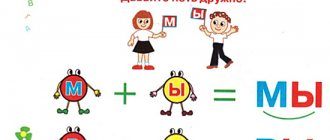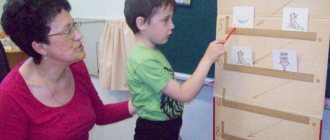In the first few years of a child’s life, the part of the brain responsible for speech development occurs. Failures that occur at this stage must be corrected. Parents often do not pay attention to the fact that the child changes syllables. However, in some cases this may indicate the presence of a deviation, so it is better to consult a specialist. If he discovers a pathology, then only a speech therapist can help get rid of it. But don’t worry too much if your baby gets confused about the syllables. In some cases, this is an age-related phenomenon.
With normal development, three-year-old children begin to reproduce verbal structures according to the laws of euphony. At the age of 1.5 to 2 years, rearrangement of syllables is allowed. For example, instead of the word “plane,” a child may say “baby.” But if such violations do not disappear by 4-5 years, then this indicates the presence of a violation of the syllabic structure of the word. Such problems do not go away on their own, so the help of a speech therapist is necessary.
What is dyslexia?
An attentive speech therapist, during a qualitative examination of a child in kindergarten, should suspect possible difficulties with the formation of the reading process. However, most often parents hear the diagnosis of dyslexia for the first time when a first-grader has problems learning to read and write.
Dyslexia is a partial impairment of the ability to master reading skills.
If a child mixes up letters at the beginning of learning, this does not mean that he has serious problems. Please note if the child:
- replaces graphically similar letters (I – Sh, B – D);
- reads letter by letter;
- mixes or replaces graphemes that indicate similar-sounding sounds;
- skips syllables or letters when reading, rearranges, adds;
- skips words, sentences, or even entire paragraphs;
- does not understand the meaning of what is read;
- closes one eye while reading.
If the above symptoms are persistent and appear periodically, consult a specialist , because the problem of dyslexia is solved comprehensively - your child may be recommended to visit a neurologist, ENT specialist, psychologist, ophthalmologist and speech therapist.
Well, well, calm down. Your baby is normal, completely normal. He cannot be capable in all areas. Therefore, we do not escalate the situation and certainly do not blame him for the problem that has arisen. Follow the doctors' recommendations, be prepared for the fact that classes can last for years, so you and your baby will need quite a lot of patience.
Causes of impairment of writing and speech reproduction of information
Why does a child write poorly or why does a child read poorly? Not surprisingly, the causes of dysgraphia are similar to the causes of dyslexia.
- Hereditary predisposition
- Diseases suffered during the perinatal period of development, as well as various complicating factors (bad habits of the mother, complicated toxicosis, asphyxia, short interval between the mother’s pregnancies, and so on)
- Internal functional reasons (long-term somatic diseases, etc.)
- External functional reasons (improper speech education)
- Lack of school readiness for writing
- Minimal brain dysfunction
- Impaired mental function
- Attention Deficit Hyperactivity Disorder
- General speech underdevelopment
- Impaired pronunciation of speech (dysarthria)
- Strokes, traumatic brain injuries, neurosurgery and brain tumors (possibly in adulthood)
Dysgraphia, like dyslexia, can lead to many problems. Among them are a drop in educational motivation, underdevelopment of speech, school failure, undeservedly poor performance, and so on. Therefore, it is very important to realize that it is not the child’s fault that he writes incorrectly, and this problem is not related to his schooling.
Responsibility for correcting the violation lies, of course, with specialists, but first of all, with parents!
As well as the process of development of their pet as a whole. All that is required of teachers is to recognize the violation in time and provide conditions in the classroom that promote the harmonious development of children, including the correction of dysgraphia.
But is it possible to confuse dysgraphia and other developmental disorders?
How not to do this?
How to help a child suffering from dyslexia?
Of course, dyslexia requires increased attention not only from specialists, but also from parents. Help your child.
Before you start your homework on correcting the now fashionable disease, remember some rules.
- Calmness and patience. Even when your nerves are at their limit. Remember that dyslexia is not a sign of laziness, it is truly a disorder, a health problem.
- You cannot punish a sluggishly reading child for mistakes when reading.
- Praise. Highlight achievements. The situation of success is inspiring.
- Do not share your feelings about this with other people in front of your child, this can seriously hurt him.
- Dyslexia can manifest itself in different ways. Let's not go deeper, there are specialists for this.
When starting classes, remember that they should not be done occasionally, but regularly. To prevent your baby from getting bored with daily exercises, try to organize them in a fun way and do not overload the growing body.
Norms for the formation of the syllable structure of a word at different ages
- Children from 0 to 3 years old. Repeating simple syllables “ma-ma”, “ba-ba”, etc.;
- Children from 3 to 4 years old. Reproduction of words of one, two and three syllables (“mint”, “house”, “car”);
- Children from 4 to 5 years old. Reproduction of words with open syllables without a cluster of consonants (“valley”, “mitten”), words of four to five syllables and with a cluster of consonants (“tail”, “bridge”, “builder”, “crumb”, “reed” );
- Children from 5 years old. Repeating sentences with complex words (of 3-4 syllables with a combination of consonants) after adults (“a builder was working on the construction of a building”, “a hairdresser is cutting hair with scissors”, “a leak was discovered in a water pipe”).
A school-age child should be able to complete a task orally and in writing, for example, write out complex words from a sentence (of 3-4 letters with a combination of consonants), read a tongue twister, and so on.
Reading impairment: exercises to correct dyslexia
We offer you tasks that will benefit all children with dyslexia. The exercises are aimed at developing visual attention, perception and memory, enriching vocabulary and improving reading skills.
Making a word from initial letters
Place pictures in front of your child, the initial letters of which together form a word. You can use toys or any other items. Try offering the opposite option: the baby will “bewitch” the word in the same way, and you will read it.
The words are lost
“There are words hidden in the room that begin with the sound R. Let’s look for them.” Next, complicate the task and ask them to find objects that end with a certain sound.
Letter from memory
The child must read the word and remember it, and then write it. Happened? We complicate the task and offer a phrase and a sentence.
Fix the word
Invite your child to make a word from a set of syllables. At the very beginning of learning, if difficulties arise, show a hint picture.
Velcro words
“The words are stuck to each other. They need to be helped to separate.”
MOMDAPAGRANDMOTHERGRANDFATHERWORDPICTURE
Subsequently, complicate the task and offer to divide the sentence into words.
I'M GOING FOR A WALK. I BOUGHT A BEAUTIFUL DOLL. ITS NATASHA.
Word game
We all played "city games". The principle of playing with a child is similar, only define the theme more simply. Or even without it at all. Just come up with a chain of words together that end with the last sound of the previous one. For example: mother - album - chalk - moon - aquarium.
Find the word
Print rows of letters on a piece of paper, among which the child must find a certain word. For example, "sausage". To begin with, you can make the task easier and place a card with the lost word in front of your student.
Culinary ABC
While you are preparing lunch, give your child the task of laying out “pasta” diagrams - the number of pasta should correspond to the number of sounds in the word. It’s great if you come up with your own personalized sound designation system together. For example, pasta represents vowels, beans represent hard consonants, and peas represent soft consonants. The result is an unusual “food” pictogram.
We write, we sculpt, we cut out
If a first-grader mixes visually similar letters when reading, you can use the exercises that are suggested for eliminating dysgraphia (writing impairment). We wrote about this in the article Dysgraphia: a buzzword or a terrible diagnosis?
Together with your child, look for objects that resemble naughty letters, write them on semolina, on foggy glass, lay them out, compare the graphemes and try to find pronounced differences. Sculpt, cut, burn on a board, lay out from beads. There are many options, if you wish.
Find out the letter from the description
"Attention! The letter disappeared, special signs - two long, even sticks, with a short one in the middle between them. An urgent search is being announced." Let your child try to tell you a riddle and describe the letter in his own words.
Letter on the back
The baby will not only improve his reading, but will also receive a nice relaxing massage when his mother draws letters, syllables and words on his back.
Find the letter
Offer your child shaded letters and objects superimposed on each other, upside down. An interesting option: add an element to a letter to create another grapheme.
Complete the letter
The essence of the task is clear from the title. Make your own cards with unfinished letters, skip individual elements. The child’s task is to restore the defective grapheme. The exercise is aimed at developing visual attention and imagination, as well as differentiating mixed letters.
The vocabulary of dyslexics is often limited, so an important part of the lessons is to work on enriching the vocabulary and developing the skill of inflection.
To make it clearer, let's look at several game options.
Call me kindly
Chair - chair, table - table, tree - tree, etc.
Whose tail?
“A cat’s is cat-like, but a dog’s? What about the wolf?
Professions
“Who raises the children? Who sews the clothes? (teacher, seamstress).”
Naughty words
“The words were playing around and became out of place. I wonder what was written. Let’s fix the proposal.” You can use pictures to help.
Don’t forget to buy your child children’s magazines with crosswords, anagrams and other “developmental” games.
Cases when medication or physiotherapeutic treatment is necessary
If there is an organic cause of dysgraphia, then its treatment will be prescribed (medication, physiotherapy, and so on). Similar methods of treatment are prescribed for aggravated disorganization of written speech, leading to the impossibility of writing (Agraphia). Various exercises will be carried out with a speech therapist. You can apply some of them yourself and work with your child at home, in this way you will not only help with the correction, but also get closer to your baby.
Stage No. 4. Composing a syllable
When the baby learns the first three vowel sounds, each subsequent sound (after familiarization with the letter) is immediately included in the syllables. The main thing is to explain this so that the child understands the very mechanism of merging two sounds into one single syllable. An adult must show two letters and say that now he will pronounce them together, without stopping or separating.
For additional effect, you can add visualization:
- place two cubes side by side;
- write letters on the parts of the construction set and connect them together;
- put the letters in one house, etc.
Having shown the child a syllable, the adult must pronounce it clearly and drawlingly, and then ask the child to repeat it. Next, you should explain in words that in order to pronounce the syllable “ma”, you must first close your lips for the sound [m] and immediately open your mouth and round your lips to pronounce the sound [a]. It is recommended to demonstrate this process several times, inviting the child to do the same.
As practice shows, such detailed explanations and training will be needed only for the first 1-2 weeks of syllabic reading classes. As soon as the child understands and masters the principle of combining sounds into syllables, he will easily do this in any combination.
In addition to learning to read direct syllables (consonant + vowel), you need to offer him to read reverse (vowel + consonant) and complex (2-3 consonants + vowel) syllables. The technique is similar: demonstrate a sample, analyze the articulation and perform training exercises.






